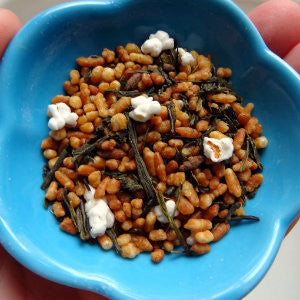
Call it popped rice tea.
If America is symbolized by baseball and apple pie, then Japan's symbols are rice and tea. Genmaicha is just that. It's green tea blended with roasted and popped white rice. This blended tea creates a nice balance of the vegetal flavors of the green tea with the nutty, somewhat sweet flavor of the rice. The roasted rice sometimes pops, not unlike popcorn, leading to the nickname "popped rice tea".
 Genmaicha is also called "poor man's tea". Rice was added to green tea as a filler, to make the very expensive tea last longer. It also added a bit of substance to the tea, and so it was often consumed by people who were fasting, and by people who simply had to go a long time between meals.
Genmaicha is also called "poor man's tea". Rice was added to green tea as a filler, to make the very expensive tea last longer. It also added a bit of substance to the tea, and so it was often consumed by people who were fasting, and by people who simply had to go a long time between meals.
Little did the wealthy people know, these poor Japanese had created an entirely new drink, and one which had it's own new, unique flavor. Genmaicha is heartier than most green teas. It has a warm, hearty flavor, and a simple taste.
>>>>>Order some Genmaicha Today <<<<<<<
The is effectively the chicken noodle soup of teas. It is generally considered to be good for settling an unhappy stomach, for the sinuses, due simply to the fact that it is a hot liquid, and a way to get a handful of calories into someone who is simply too sick to eat at the moment.
 A totally untrue story about the origin of this unusual tea involves a servant and a cruel master who was a warrior. The servant, named Genmai, was preparing the master's tea when he accidentally spilled some rice from the cuff of his robe into his cup. The angry master then kills the servant but drinks the tea. After drinking the tea, which he found to be delicious, he is overcome with grief and calls the tea Genmaicha or Genmai's Tea.
A totally untrue story about the origin of this unusual tea involves a servant and a cruel master who was a warrior. The servant, named Genmai, was preparing the master's tea when he accidentally spilled some rice from the cuff of his robe into his cup. The angry master then kills the servant but drinks the tea. After drinking the tea, which he found to be delicious, he is overcome with grief and calls the tea Genmaicha or Genmai's Tea.
One of the biggest giveaways as to why this story can't possibly be true is that Genmai means rice, and I can't imagine that someone would name their son Rice. Imagine that. What is your son's name? Oh, this is Rice. Rice, eat your rice.
Meanwhile, Cha (茶) means tea, which makes the full name of this tea rice tea. Very creative, I know. The use of the above Kanji character suggest strongly suggest the peasant origins of this tea. In Japan, this tea is often referred to as the "peoples' tea" as it is affordable and perhaps, at one time or another, likely during times of war, was drank by everyone out of necessity rather than choice. A contemporary tale of original Genmaicha is attributed to a Kyoto tea merchant who claims to have created it.  While Genmaicha used to be made from unmilled rice and low-quality tea, today it is made with a uniformly roasted rice and the grade of the tea used is greatly improved. Since World War II, as Japan's economy has improved, this people's tea's popularity increased as better tea leaves are used. As its popularity has spread in Japan, so it has in the west. Now the balanced taste of tea and rice makes it an easy tea for newbies to drink and a staple for green tea lovers.
While Genmaicha used to be made from unmilled rice and low-quality tea, today it is made with a uniformly roasted rice and the grade of the tea used is greatly improved. Since World War II, as Japan's economy has improved, this people's tea's popularity increased as better tea leaves are used. As its popularity has spread in Japan, so it has in the west. Now the balanced taste of tea and rice makes it an easy tea for newbies to drink and a staple for green tea lovers.
Even if you aren't a poor peasant, living through living in lean times, or sick, this humble tea has a simple and hearty taste which you're sure to love. It reminds me a bit of that scene from the animated movie Ratatouille, when they need to make a particularly spectacular dish at a fancy restaurant, and in spite of all of the resources available to them, they make a simple peasant dish. It's quite heartwarming, if you've seen it. If you haven't, I'm sure you still get the idea.
